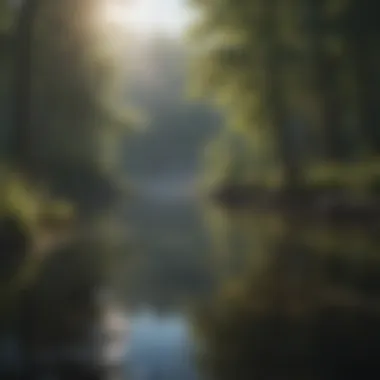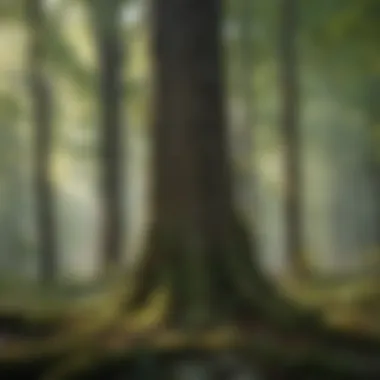Unveiling the Diverse Natural Beauty of New York State


Nature Topic Overview
New York is a mesmerizing tapestry of natural wonders waiting to be explored. From the towering mountains that kiss the sky to the tranquil lakes that mirror the heavens above, the state is a haven of diverse landscapes and thriving ecosystems. In this article, we will delve into the captivating world of New York's natural beauty, exploring its rich biodiversity and ecological significance.
Fun Facts and Trivia
As children embark on this journey of discovery, they will be thrilled to learn some fascinating facts about New York's natural wonders. Did you know that Adirondack Park in New York is larger than Yellowstone, Everglades, Grand Canyon, Glacier, and Olympic National Parks combined? This park offers a sanctuary for hundreds of species of flora and fauna, making it a biodiversity hotspot within the state. Additionally, the iconic waterfall, Niagara Falls, is not only a breathtaking sight but also a vital source of hydropower for the region. These tidbits of information will engage young readers and pique their curiosity about the natural world around them.
Wildlife Explorations
Delving deeper into the wilderness of New York, children will encounter a plethora of mesmerizing wildlife species. From the elusive red foxes that roam the forests of the Catskill Mountains to the majestic bald eagles soaring high above the Hudson River, the state is teeming with diverse animal life. Exploring the wetlands of Montezuma National Wildlife Refuge might reveal the graceful great blue herons or the comical antics of a family of river otters. Through interactive quizzes and puzzles, children can test their knowledge of these fascinating creatures and learn more about their habits and habitats.
Environmental Awareness
Amidst the natural splendor of New York, it is crucial to instill a sense of environmental awareness and conservation values in young minds. By understanding the importance of conservation and sustainability, children can become proactive stewards of the environment. From learning about energy conservation to recycling tips, children can discover practical ways to help protect nature and preserve its wonders for future generations. Through engaging activities and thought-provoking questions, children can reflect on their role in creating a more sustainable and eco-conscious world.
DIY Nature Activities
To immerse children in the wonders of nature, hands-on activities and DIY projects provide a tangible connection to the environment. Crafting bird feeders from recycled materials, creating nature journals to document outdoor adventures, or designing leaf rubbings to showcase the intricate patterns of plant life – these activities spark creativity and curiosity. Moreover, suggestions for outdoor explorations such as nature scavenger hunts or star-gazing nights offer children the opportunity to apply their knowledge and appreciation of New York's natural landscapes. By engaging in these interactive and educational experiences, children can foster a deep love for nature and embark on a lifelong journey of exploration and conservation.
Introduction
New York's natural beauty stands as a captivating testament to the diverse landscapes that grace this vibrant state. From majestic mountains to serene lakes and lush forests, New York offers a rich tapestry of biodiversity and ecological significance waiting to be explored. This article serves as a comprehensive guide to unraveling the enchanting natural wonders that define New York's landscape, providing insights into its flora, fauna, and conservation efforts.
Overview of New York's Natural Beauty
Geographical Features
Delving into New York's geographical features unveils a landscape characterized by its varied terrains and topographical splendor. From the Adirondack Mountains to the Catskill region, the state's diverse geography not only offers visual grandeur but also plays a crucial role in shaping its ecosystems. The Adirondacks, with their towering peaks and pristine lakes, stand as a cornerstone of New York's natural beauty, attracting outdoor enthusiasts and nature lovers alike. Despite the challenging terrain in some areas, these geographical features contribute significantly to the state's allure.
Climate Diversity
New York's climate diversity adds another layer of complexity to its natural beauty. The state experiences a range of climate zones, from the snow-capped mountains in the north to the temperate climates along the coastal regions. This diversity not only supports a wide array of ecosystems but also offers a unique experience for visitors exploring its natural wonders. While the climate can present challenges in certain areas, its overall contribution to the state's ecological richness cannot be understated.
Ecological Importance
The ecological importance of New York's natural beauty extends far beyond its aesthetic appeal. The state's diverse ecosystems provide habitat for a vast array of plant and animal species, contributing to the overall biodiversity of the region. From wetlands teeming with life to ancient forests supporting rare species, New York's ecological significance underscores the need for conservation efforts to preserve these invaluable resources. While facing threats from human activities, the ecological importance of New York's natural beauty remains a key focus for environmental stewardship.
Historical Perspective
Native American Influence
Exploring the Native American influence in New York reveals a deep connection to the land and its resources. The indigenous tribes that once inhabited these lands left a lasting legacy on the state's culture and natural landscapes. Their sustainable practices and harmonious relationship with nature offer valuable insights into coexisting with the environment. Despite historical challenges and disruptions, the influence of Native Americans continues to shape New York's conservation efforts and environmental policies.


Colonial Era Impact
The Colonial Era impact on New York's natural beauty marked a significant shift in land use and resource management. The arrival of European settlers brought about changes that would alter the state's ecosystems forever. Land development, deforestation, and introduction of non-native species are some of the lasting impacts that continue to shape the landscape today. Understanding this historical perspective is crucial in contextualizing the current conservation challenges faced by New York.
Conservation History
New York's conservation history reflects a journey of awareness, activism, and preservation efforts aimed at safeguarding its natural treasures. From the establishment of the Adirondack Park in the 19th century to the modern-day sustainability initiatives, the state has witnessed a gradual evolution in its approach to environmental conservation. The conservation history of New York serves as a testament to the ongoing commitment to protecting its ecosystems and promoting responsible stewardship among its residents and visitors.
Flora and Fauna
The section on Flora and Fauna in this article focuses on the vital aspects of New York's botanical and wildlife diversity. As an integral part of the state's natural wonders, Flora and Fauna play a crucial role in shaping the ecosystem and maintaining ecological balance. The richness of plant species and animal life in New York contributes significantly to its enchanting landscapes and biological importance.
Plant Species Diversity
Native Flora
Native Flora in New York represents a key element of the state's biodiversity. These indigenous plant species have evolved over time to adapt perfectly to the local environment, fostering sustainability and preserving ecological heritage. Their resilience and compatibility with New York's climate make them essential for maintaining the region's natural equilibrium. Despite facing threats from habitat loss, efforts towards protecting and propagating native flora are essential to ensure the continuity of diverse plant species within the state.
Invasive Species
The presence of invasive species poses a significant challenge to New York's ecosystems. These non-native plants can outcompete indigenous flora, disrupting the delicate balance of local habitats. Invasive species often spread rapidly, threatening the survival of native plants and altering ecological dynamics. Effective management strategies are crucial to control the spread of invasive species and mitigate their negative impact on New York's diverse plant communities.
Botanical Gardens
Botanical gardens in New York serve as essential centers for conserving and showcasing a wide array of plant species. These curated collections provide educational opportunities for visitors to learn about the importance of different plants, both native and exotic. Botanical gardens contribute to botanical research, conservation, and public awareness, making them valuable resources for enthusiasts and conservationists alike.
Wildlife Encounters
The section on Wildlife Encounters celebrates the diverse animal life found throughout New York. From mammals to birds and reptiles, encounters with wildlife offer a unique opportunity to connect with nature and appreciate the beauty of the state's fauna.
Mammals
Mammals play a significant role in New York's ecosystems, contributing to biodiversity and ecosystem stability. From the majestic black bears to the elusive bobcats, the state is home to a variety of mammalian species. Understanding their behaviors and habitats is crucial for conservation efforts and ensuring the coexistence of wildlife and human populations.
Birds
Birds are prominent features of New York's natural landscapes, with a rich diversity of species residing across the state. From songbirds to raptors, each bird plays a vital role in the ecosystem, contributing to pollination, seed dispersal, and pest control. Birdwatching opportunities abound in New York, offering bird enthusiasts a chance to observe these feathered creatures in their natural habitats.
Amphibians and Reptiles
Amphibians and reptiles are essential components of New York's biodiversity, with their presence indicating the health of aquatic and terrestrial ecosystems. Species like the red-spotted newt and eastern box turtle contribute to the state's ecological balance. Understanding the unique adaptations and behaviors of amphibians and reptiles is crucial for fostering conservation initiatives and preserving their habitats.
Parks and Reserves


Parks and reserves play a vital role in preserving the natural wonders of New York. These protected areas not only safeguard the biodiversity and ecosystems but also provide essential habitats for various plant and animal species. Additionally, parks and reserves offer opportunities for outdoor recreation, education, and research, making them integral to the state's environmental conservation efforts.
Adirondack Park
Montane Habitats
Montane habitats within Adirondack Park are characterized by their high elevation and unique climatic conditions, fostering a diverse array of plant and animal species specially adapted to these environments. The key characteristic of montane habitats lies in their rich biodiversity, with many rare and endemic species found exclusively in these high-altitude zones. Despite their isolation and harsh conditions, montane habitats provide crucial ecosystem services and act as important refuges for alpine flora and fauna.
Conservation Initiatives
The conservation initiatives in Adirondack Park focus on preserving its natural heritage through sustainable land management practices and biodiversity protection strategies. One crucial aspect of these initiatives is the restoration of degraded habitats and the monitoring of vulnerable species to ensure their long-term survival. By engaging local communities and stakeholders in conservation efforts, Adirondack Park aims to strike a balance between human development and environmental stewardship.
Outdoor Recreation
Outdoor recreation opportunities abound in Adirondack Park, attracting nature enthusiasts, hikers, campers, and wildlife observers from near and far. The park's extensive trail network, pristine lakes, and scenic vistas offer ideal settings for various recreational activities like hiking, boating, fishing, and birdwatching. Through responsible outdoor recreation, visitors can appreciate the park's natural beauty while minimizing their ecological impact, contributing to the sustainable use of this treasured landscape.
Central Park
Urban Oasis
Central Park stands out as an urban oasis amidst the bustling cityscape of New York City. Its lush greenery, tranquil water bodies, and diverse plant collections provide a refreshing escape from the concrete jungle, offering residents and visitors a natural retreat in the heart of the metropolis. The key characteristic of Central Park as an urban oasis lies in its ability to support a wide range of flora and fauna within a densely populated urban environment, promoting biodiversity and ecological resilience.
Biodiversity Hotspot
Central Park serves as a biodiversity hotspot, hosting a remarkable variety of plant and animal species within its boundaries. The park's diverse habitats, including woodlands, meadows, and ponds, create ideal conditions for wildlife to thrive in an otherwise urbanized landscape. By preserving and enhancing its biodiversity, Central Park exemplifies the coexistence of nature and city life, illustrating the importance of green spaces in fostering ecological balance within urban settings.
Historical Significance
Central Park's historical significance stems from its inception as a pioneering example of landscape architecture and urban planning in the mid-19th century. Designed by Frederick Law Olmsted and Calvert Vaux, the park remains a testament to their vision of a harmonious blend of natural and man-made elements, shaping the concept of public parks in American cities. The unique feature of Central Park lies in its role as a cultural and recreational hub, attracting millions of visitors annually to experience its beauty, heritage, and seasonal attractions, making it a timeless symbol of New York's commitment to preserving green spaces amidst urban development.
Waterways and Lakes
Waterways and Lakes play a crucial role in showcasing the natural wonders of New York. The abundance of water bodies contributes significantly to the state's ecological diversity and scenic beauty. Lakes, like the iconic Finger Lakes, are not only breathtaking in their appearance but also support diverse aquatic life and provide recreational opportunities for locals and visitors alike. Rivers such as the historic Hudson River offer a unique glimpse into the estuarine ecosystems and challenges faced by urban water bodies.
Finger Lakes
Glacial Origins
The Finger Lakes region in New York owes its distinctive landscape to the glacial origins that sculpted these long, narrow lakes. The formation of these lakes through glacial erosion and movement has created deep freshwater basins that support a wide range of aquatic habitats. The unique shape and depth of the Finger Lakes attract researchers and nature enthusiasts alike, drawn to the geological significance and ecological richness offered by these glacial relics.
Aquatic Species
The thriving ecosystem of the Finger Lakes is home to a plethora of aquatic species, from fish to invertebrates, each playing a vital role in maintaining the lake's ecological balance. The diversity of aquatic life in these lakes serves as a testament to the resilience and adaptability of native species in the face of environmental changes. However, the presence of invasive species poses a threat to the delicate balance of these aquatic ecosystems, warranting dedicated conservation efforts to preserve the biodiversity of the Finger Lakes.


Water Sports
Water sports enthusiasts flock to the Finger Lakes region to indulge in a variety of recreational activities such as boating, fishing, and swimming. The calm waters and picturesque surroundings of these lakes provide the perfect setting for outdoor water-based adventures, attracting tourists and locals seeking both relaxation and excitement. However, sustainable practices and responsible tourism are essential to ensure the preservation of the natural beauty and ecological integrity of these beloved water bodies.
Hudson River
Estuarine Ecosystem
The Hudson River estuary stands as a critical ecological hub, supporting a complex network of fauna and flora adapted to brackish water conditions. The convergence of freshwater and saltwater along the estuarine reaches of the Hudson River creates a dynamic environment that fosters biodiversity and sustains vital habitats for aquatic species. The estuarine ecosystem of the Hudson River serves as a living example of resilience and adaptation in the face of environmental pressures and anthropogenic activities.
Riverfront Development
The development along the Hudson River waterfront has undergone transformations over the years, balancing urban expansion with environmental conservation efforts. The revitalization and preservation of riverfront areas aim to enhance public access to the river while protecting its ecological integrity. Green spaces, walkable promenades, and sustainable infrastructure initiatives characterize responsible riverfront development, fostering a harmonious coexistence between urban amenities and natural landscapes.
Ecological Challenges
Despite significant conservation efforts, the Hudson River faces ongoing ecological challenges stemming from pollution, habitat degradation, and overexploitation of natural resources. The delicate balance of the estuarine ecosystem is threatened by industrial activities, urban runoff, and climate change impacts, necessitating continuous monitoring and advocacy for sustainable practices. Addressing these challenges requires a multi-faceted approach that involves stakeholder engagement, policy reforms, and community-driven initiatives to ensure the long-term sustainability of the Hudson River ecosystem.
Conservation Efforts
In the realm of nature conservation in New York, the focus is on preserving the state's natural treasures for future generations. Conservation efforts play a vital role in safeguarding the diverse ecosystems, ensuring biodiversity, and mitigating the impact of human activities on the environment. By actively participating in conservation initiatives, individuals and organizations contribute to the sustainability of New York's natural wonders.
Protected Areas
State Parks
State Parks in New York are crucial components of the conservation strategy. These parks serve as havens for diverse flora and fauna, allowing people to connect with nature and appreciate its beauty. Offering recreation, education, and preservation opportunities, State Parks contribute significantly to the overall biodiversity conservation goals. They provide habitats for numerous plant and animal species, fostering ecological balance and serving as outdoor classrooms for environmental education.
Nature Preserves
Nature Preserves are designated areas specifically set aside for the protection of native wildlife and plant species. These pristine environments act as sanctuaries, free from human interference, allowing ecosystems to thrive in their natural state. By safeguarding these delicate ecosystems, Nature Preserves uphold crucial biodiversity hotspots, ensuring the survival of rare and endangered species.
Wildlife Refuges
Wildlife Refuges play a pivotal role in protecting and managing habitats for wildlife conservation. These designated areas provide safe havens for migratory birds, nesting species, and other wildlife, fostering biodiversity and wildlife sustainability. By maintaining undisturbed habitats and enforcing conservation regulations, Wildlife Refuges contribute significantly to the protection of New York's rich biological heritage.
Sustainability Initiatives
Green Practices
Green Practices focus on implementing environmentally friendly methods to reduce ecological impact and promote sustainability. In New York, embracing green practices such as recycling, waste reduction, and energy conservation leads to a more environmentally conscious society. By integrating green practices into daily routines and industries, individuals and communities can contribute to a healthier and greener future.
Renewable Energy
Renewable Energy sources, such as solar and wind power, play a critical role in reducing dependence on fossil fuels and mitigating carbon emissions. By harnessing renewable energy technologies, New York aims to transition towards a cleaner and more sustainable energy landscape. Embracing renewable energy not only reduces environmental harm but also creates economic opportunities and enhances energy security.
Community Engagement
Community Engagement is essential for fostering environmental awareness and promoting sustainable practices on a local level. By involving communities in conservation projects, educational programs, and green initiatives, New York stimulates collective action towards environmental stewardship. Through community engagement, individuals feel empowered to make a positive impact, leading to a more environmentally conscious and sustainable society.







